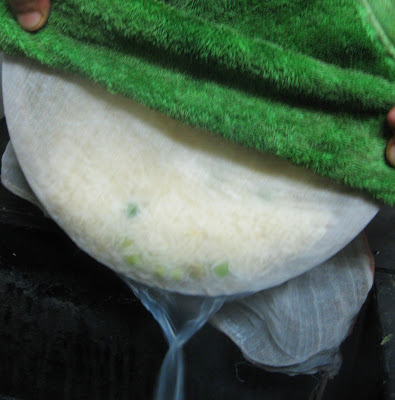This is a quick overview of the Nabami dinner The Parents and I hosted for a tiny number of people. Four, to end potential speculation. Again, since the camera is considered superfluous by all parties concerned except me, the pictures were all sneaked in while people were busy elsewhere, and much caustic commentary was digested along the way.
How I suffer for my Purpose in Life.
Okay, a quick word on menu composition. As cosmopolite, gourmet, and my favourite author Syyed Mujtaba Ali said aeons ago, Bengalis don't know the first thing about composing menus. Take the average Bengali wedding feast, he said. Consider it for a moment. People are herded in lines onto poky wooden chairs behind rickety tables arranged in crowded rows. Men in greasy stained clothes zoom past their rows, tossing food on their [organic, decompasable] plates like so many newspapers on so many wet lawns. There is no room for complaint or special requests or plain old choice, unless one vaults over said rickety tables in all of one's wedding finery, and chases after said men in said greasy outfits through said crowded rows, demanding gastronomic justice, and creating comic relief for all.
But since life isn't a Priyadarshan film, one sits quietly next to myriad strangers from one's super-extended family, positions oneself cautiosly away from the table to protect pwetty clothes from the sudden splat! of gravy courtesy aggressive servers, and dutifully eats cold, elastic luchis with rock-hard barely-cooked potatoes, two kinds of daal, both equally watery, an indifferent slice of fish, a boney, sinewy piece of mutton in cold gravy, a limp, soggy dish-rag of a papar, a roshogolla that lands smack in the middle of the leftover daal, and a plate of ice-cream so warm it melts into a gooey puddle right before your eyes.
Our aim was to NOT re-create this harrowing hospitality experience.
So our menu was, while otherwise quientessentially 20th century Bengali, brief and coordinated. We ate: pea polau (pulao), fish-fry made with bhetki (bass), mustard-baked bass (sort of like this, but with bass), kosha mangsho (mutton in a rich, spicy gravy), and tomato-amshotto-kaju-kishmisher chutney. All of these, amazingly enough, are really rather easy to make. The fish fry is simplest of all, and the recipe is exactly the same as the prawn cutlets. So let's skip ahead to pea-polau. This is the easier, healthier version my parents prefer. I cook it slightly differently.
Ingredients:
Lobongo, chhoto aelach, daarchini (cloves, small green cardamoms, cinnamon).
Peas, fresh or frozen (not out of a tin).
Basmati or other long-grained rice.
Bay leaf--2.
Sugar, salt.
Garam masala, powdered at home.
Kaju kishmish (unsalted cashews and sultanas)
Ghee.
How to:
Dry-roast the cloves, cardamom and cinnamon for a couple to five minutes, tossing so it doesn't char. This is called tele newa (hard 't') at home, but I've heard the phrase "shukno khole bhaja" for it too. When you can smell the roasting spices, take them off the flame. Using the back of your big knife, crush the cardamoms so the seeds break out of the pod and are half-broken. Also lightly crush the cloves and cinnamon.
NOTE: To make garam masala at home, extract the cardamom seeds and dry-grind it with the cloves and cinnamon.
Wash the rice under a cold tap. Boil water in a hNaari or a large, deep pan with the dry-roasted spices. After five to seven minutes, when the water has been flavoured by the spices, add rice and peas. Cook till almost-done, with half a teaspoon of salt and two bay leaves. The un-metric rule of thumb is that the level of water should be an inch above the level of rice.
Tie a net/cloth drainer around the hNaari, pot and drain ALL excess water. This can be done without the net, but the chances of burning one's fingers and retaining unwanted water is quite high. Sprinkle sugar on the rice according to your tastes, and mix it in thoroughly. Cover and keep aside (the sugar will be cooked in the heat, like eggs in a carbonara).
Heat about five or six tablesppons of ghee in a wok or skillet. If you're heart-conscious, you can use one heaped teaspoon of ghee for flavouring, and use sunflower/canola oil for the rest. When hot, turn the heat down and add the unsalted cashews and sultanas. Stir thoroughly on medium till the white sultanas turn ivory and even slightly golden. The sultanas should swell a little with the absorption of ghee. This should take a couple of minutes.
Now pour this seasoning on the drained and kept-aside rice, and mix thoroughly. If the rice looks dry after this, heat more ghee and add, folding it in again.
Add garam masala powder, and fold that in as well.
Serve with kosha mangsho and baked fish (recipes to follow :-)

























































